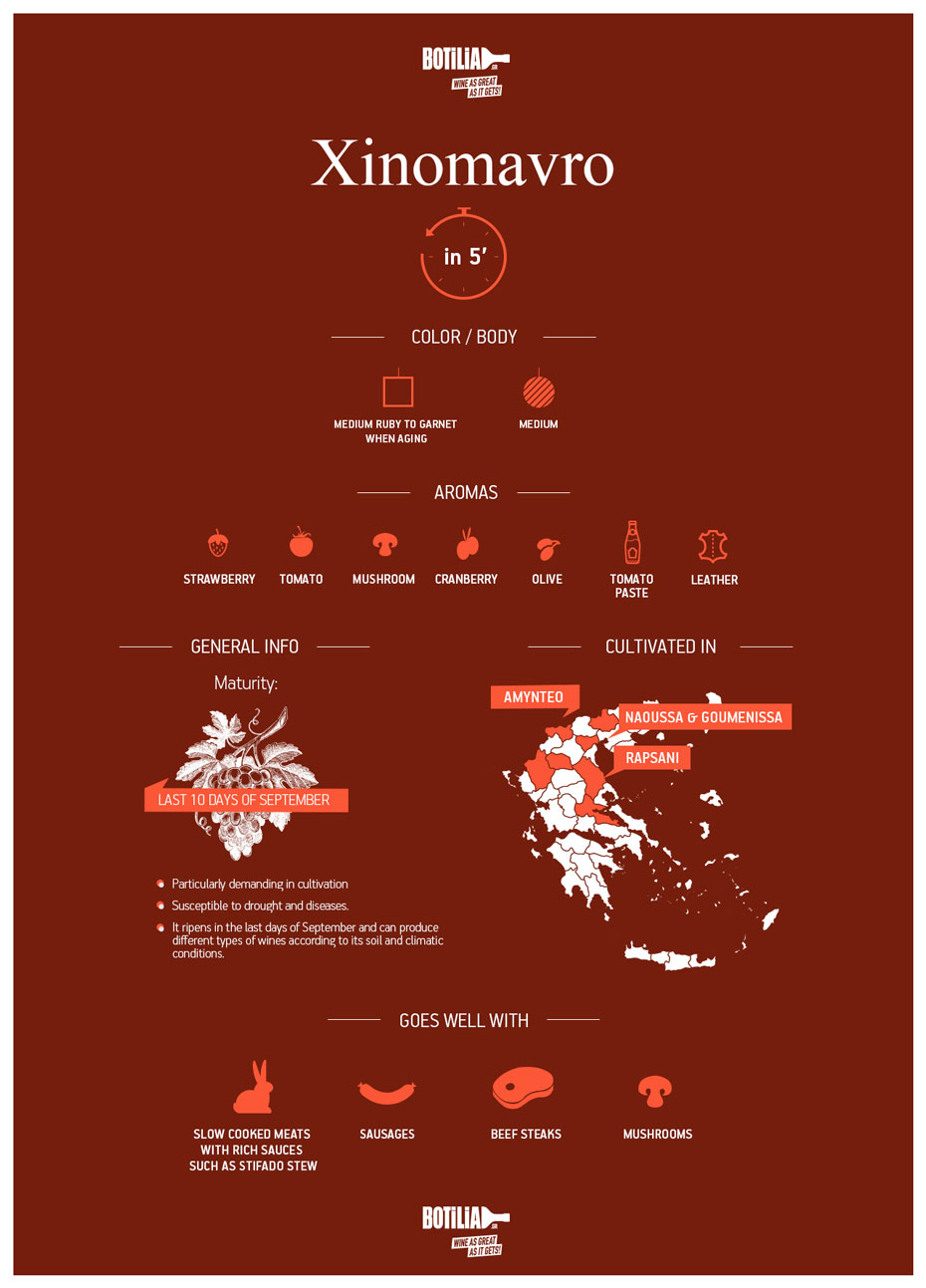XINOMAVRO IN 5'!

General info
Xinomavro is a uniquely special variety. It gives wines with very distinctive aromas and flavors that are often recognized even with eyes closed. Its name means sour and black grape, although its berries are not as deep in color. Many compare it with Nebbiolo or Pinot Noir because of its herbaceous character and its high acidity.
It is a particularly demanding variety as it deserves special attention both during cultivation and ripening as well as during vinification. It gives wines with high acidity and tannins. Recently two diffirent styles have emerged: a) the modern version, giving deep-coloured wines with more concentrated fruity aromas and less aggressive tannins; and b) the rustic version that gives wines with accented aromas of tomato, olive and dried fruits,high acidity and tannins.
In addition, it can produce rosé and white wines, using the blanc de noir method, but also very impressive sparkling wines. Xinomavro is solely responsible for or participates in the following red wines: PDO Naoussa, PDO Amynteo, PDO Goumenissa (Xinomavro - Negoska) and PDO Rapsani (Xinomavro-Krasato-Stavroto), as well as in the dry and sparkling wines of Amyntaio (PDO Amynteo).
History
At the beginning of the 20th century, the vineyards of Naoussa were affected by phylloxera and gradually destroyed. In the 1960s, an effort to revive the vineyards of the region began. Giannis Boutaris in 1968, transforms 520 acres of wild trees and shrubs into a vineyard in Giannakochori, Naoussa, cultivating Xinomavro.
Finally, in 1972 Naoussa was legally established as a wine-growing zone of the Designation of Origin and after intensive efforts it reaches today 7,000 acres. More than 30-40% of Naoussa's wines are exported, and the international acceptance is that Xinomavro has been planted up to Penedes in Spain by the Torres Winery (one of the most famous).
Characteristics
The variety gives red wines with moderate body, high acidity and intense tannins. In the glass the color may vary from moderate ruby to garnet, depending on vinification and aging.
The dominant and most characteristic aroma of Xinomavro is tomato, in various versions, from fresh to sun dried and from paste to marmalade. In addition, it has aromas of olive (black, paste or leaves), red fruits (strawberry, cranberry, redcurrant), intense herbal (sage, rosemary, eucalyptus) and earthly (mushroom, soil) character. When it ages it acquires aromas of truffle, licorice, dried fig and raisin. Often there are also some animal notes such as leather. The wines from Amynteo have more fruity aromas but also flowers (violet) while they are less vegetal. Similarly, wines from the Rapsani region also have strong aromas of strawberry, cherry and spices.
In the rose versions, the color varies from salmon to pink, it has aromas of strawberry, rose and tomato jam, light body and medium to high acidity. In blanc de noir versions, there is more intense vegetation, presence of olive and citrus fruits.
Combination with food
Xinomavro loves food and the pairings are many. The reds go very well with xtews with tomatoes, such as beef, yuvetsi and stifado. They also accompany steaks, from various cuts and breeds. The aged versions demand complexity and finesse: gamey dishes such as wild boar with dried plums, wild mushroom dishes and truffles such as risotto but also complex aged cheeses like a 5-year-old Naxos gruyere. Avoid fish because tannins do not help at all and the result is a strong "fish" and metallic flavor.
Rose are excellent with pasta with red sauces, vegetable dishes like stuffed tomatoes and green beans giachni. The white Xinomavro versions have a nice herbaceous character and acidity that would take off a fishy fricasse, but also it goes well with mussels, grilled, stuffed squid and chicken with lemon sauce.
Sparkling is a completely different category: from shellfish to a rich caccio e pepe pasta, the combination will be enchanting.
Eva Markaki
Wine Geek


